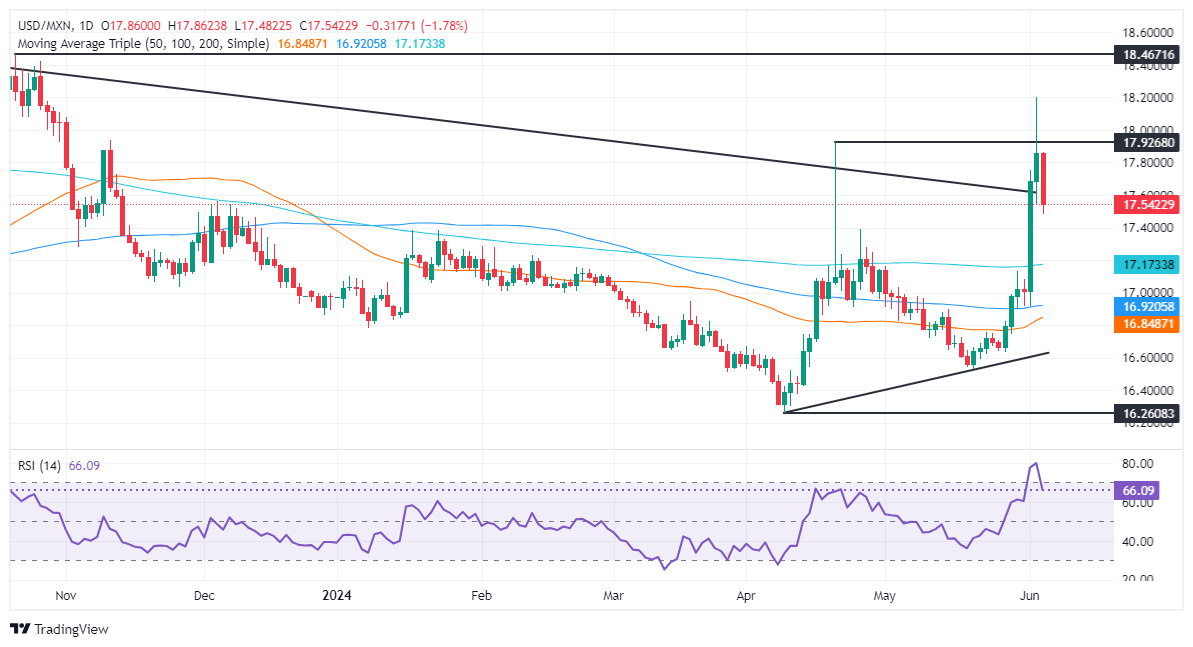Mexican Peso rallies as finance minister restore confidence following general elections

- Mexican Peso gains over 1.50% Wednesday after peaking at 17.85 earlier.
- Finance Minister Rogelio Ramirez de la O reassures markets about financial discipline and investment facilitation.
- US economic data was mixed as ADP employment figures disappoint, while ISM Services PMI exceeds estimates.
The Mexican Peso stages a recovery against the US Dollar, printing gains of more than 1.50% on Wednesday following Mexican Finance Minister Rogelio Ramirez de la O’s press conference on Tuesday that attempted to calm the financial markets.
Although data from Mexico and the United States would warrant further upside, the pair seems to have stabilized after two days of volatile sessions following Sunday’s presidential election that saw Dr. Claudia Sheinbaum lead the ruling Morena party to victory. The USD/MXN trades at 17.54 after hitting a daily high of 17.85.
“We want to confirm to international organizations and private investors that our project is based on financial discipline, abiding by the autonomy of the Bank of Mexico, adherence to the rule of law and facilitating national and foreign private investment,” said Ramirez de la O, according to a translation by El Financiero.
Some analysts considered his message vague, and doubts continue to cloud Dr. Claudia Sheinbaum’s upcoming presidency due to the strong majority of the Morena party.
USD/MXN traders ditched the emerging market currency because they feared Morena’s overwhelming victory in Congress could threaten to eliminate autonomous regulators like the National Elections Institute and push a bill for direct election of Supreme Court judges.
Meanwhile, Mexico’s economic docket revealed that consumer confidence deteriorated further in May than in April.
Across the border, US employment figure estimates in the ADP Employment Change report came below estimates, reaffirming that the US labor market is cooling. However, May’s latest ISM Services PMI figures exceeded estimates and expanded sharply, boosting appetite for the Greenback.
Daily digest market movers: Mexican Peso shrugs off election fears and advances
- Mexican Consumer Confidence fell to a seven-month low of 46.7 in May, below April’s 47.7.
- September would be a crucial month for the Mexican Congress. Morena’s majority could push bills blocked by the opposition, including the reduction of lawmakers and plans for direct election of the Supreme Court members.
- Morgan Stanley noted that if Mexico’s upcoming government and Congress adopted an unorthodox agenda, it would undermine Mexican institutions and be bearish for the Mexican Peso, which could weaken to 19.20.
- Speculation of another Banxico rate cut in June could pave the way for further upside in the USD/MXN.
- Institute for Supply Management (ISM) revealed that business activity in the US service sector expanded. The ISM Services PMI was 53.8 in May, the highest reading since August 2023, surpassing the 50.8 projected by the consensus and April’s 49.4 contraction.
- The US ADP National Employment Change in May missed the estimates of 175K and came in at 152K, lower than April’s 188K.
- Alongside a softer April JOLTS report, ADP data hints that jobs market is cooling ahead of the release of May Nonfarm Payrolls data on Friday.
- The futures market suggests the Federal Reserve might cut rates by 35 basis points in 2024, according to the December 2024 fed funds future rate contract.
Technical analysis: Mexican Peso counterattacks as USD/MXN slides below 17.60
The USD/MXN shifts to neutral bias despite posting losses close to 1.80% on Wednesday. However, Monday’s Japanese Marabuzo candlestick suggests that buyers are in charge and that the exotic pair might head back to levels below the already broken 200-day Displaced Moving Average (DMA) near 17.16.
The USD/MXN’s first resistance level would be the June 3 high at 17.74, followed by the 18.00 psychological level. Once surpassed, the next stop would be the year-to-date high of 18.19.
Momentum favors further upside as the Relative Strength Index (RSI) sits at the higher end of the graph. But RSI’s exiting from overbought conditions opened the door for a pullback toward the current day’s low of 17.48.
In the event of further losses, the next support would be the 200-DMA at 17.16, followed by the 17.00 figure, ahead of the 100-day DMA at 16.91. Once cleared, up next would be the 50-day DMA at 16.84.
Banxico FAQs
The Bank of Mexico, also known as Banxico, is the country’s central bank. Its mission is to preserve the value of Mexico’s currency, the Mexican Peso (MXN), and to set the monetary policy. To this end, its main objective is to maintain low and stable inflation within target levels – at or close to its target of 3%, the midpoint in a tolerance band of between 2% and 4%.
The main tool of the Banxico to guide monetary policy is by setting interest rates. When inflation is above target, the bank will attempt to tame it by raising rates, making it more expensive for households and businesses to borrow money and thus cooling the economy. Higher interest rates are generally positive for the Mexican Peso (MXN) as they lead to higher yields, making the country a more attractive place for investors. On the contrary, lower interest rates tend to weaken MXN. The rate differential with the USD, or how the Banxico is expected to set interest rates compared with the US Federal Reserve (Fed), is a key factor.
Banxico meets eight times a year, and its monetary policy is greatly influenced by decisions of the US Federal Reserve (Fed). Therefore, the central bank’s decision-making committee usually gathers a week after the Fed. In doing so, Banxico reacts and sometimes anticipates monetary policy measures set by the Federal Reserve. For example, after the Covid-19 pandemic, before the Fed raised rates, Banxico did it first in an attempt to diminish the chances of a substantial depreciation of the Mexican Peso (MXN) and to prevent capital outflows that could destabilize the country.
